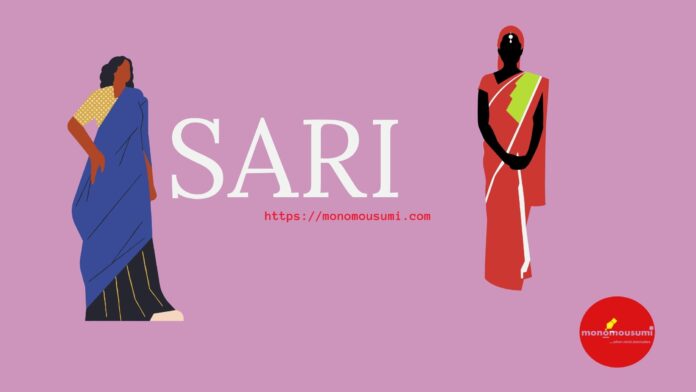The idea of dressing has been fascinated especially by women all over the world. The way of dressing can be traditional, casual, trending, ethnic wears and much more. Most of the women prefer quintessential ones for traditional occasions. The jewels and dressing styles that had been practised by the ancient people barely exists but hadn’t obliterated from the minds of the younger generations. Though the ancient styles had endured evolution, the thought of their original forms exists. Fashion designers create new trends in dressing, whilst the practice of dressing up traditionally can be seen at least on special events.
There are people who do wear traditional dresses as casuals in rural areas. One of the world’s most famous traditional wear is “sari” which is mostly worn by the woman in India. It is the safest outfit to be worn by a woman. Traditional wears can differ according to the comfort of a person, religion, climate, etc. But saris are common to almost everyone. India has always been unique for its excellence in art, craft, religion, etc. In addition to that, it holds a unique position in dressing traditionally. It has never received a claim to be said that a sari has turned out of fashion. Saris remain elegant and trending as long as the female beauty is honoured.
A sari is usually a long piece of cloth which is normally wrapped around the waist along with pleats tucked in and an end is brought over the shoulder which can cover the head too, if required. It is worn along with a midriff. The initial phase of draping a sari is said to be developed from the Indus valley civilisation. Coming to India, the practice is said to have started since the 5th millennium. As cotton was easily available those days, people started to weave saris using cotton. Later on, silk material was used. Natural dyes were used to colour the woven strips of cloths. Some of the natural dyes are – Indigo, red madder and turmeric. In the present days, the most preferred materials are polyester, georgette, and synthetic materials.
During the rule Mughal Empire, an innovative idea arose in which designs were drawn directly on saris. Those types of saris are named as ‘kalamkari saris’. Nowadays, the designs drawn depict the stories related to Hindu mythology, symbols belonging to various religions, Buddha art forms, etc. In this modern world, people have created innovative techniques to facilitate designing in these types of saris.
Another set of highly preferable ones are the ‘hand-woven saris’. India is renowned of its creative handicrafts and handlooms. These types of saris contribute excessively to the handloom sector which at the same time is the largest of the country. These saris need loads of effort and hard work to be done as it is hand woven. On the other hand, all the high-tech innovations developed to ease the process of weaving were all in vain as the cultural method of hand-weaving was irreplaceable. One of the advantages of these saris is that the last long and is highly recommended to be worn on all special occasions. They are designed adorably using vibrant and radiant colours. In the mean time, they are well suited for the Indian climatic conditions.
The world famous Silk saris acquire great attention during the wedding seasons. The most preferred colour for a bride in India is Red with golden borders. The types of silk saris differ based on the nature of the silkworm from which this unique raw material is obtained. Some of the variations are – light weight, contrast borders, innovative designs and most importantly, ensconce of a person. The process of getting a silk sari completely done is pretty difficult even to imagine. This process takes away the lives of thousands and thousands of silk worms and the efforts of numerous people who are involved in it. The rivalry for the prosperity of sericulture is being continued for ages. Some of the most famous silks are – The Assam silks, The Mysore silk, the inevitable kanchipuram silk, Banaras silk, and much more. There are even artificial silks such as rayon, polyester, etc. In short, they leave nothing to be desired. A sari can be draped according to one’s comfort. The style of draping takes account on the type of occasion, climatic conditions, the work done by a person, and most importantly, a woman’s personality. The different styles of draping a sari traditionally, especially in India are excessive in number. A few of them are mentioned below:-
- Nivi style: This style is commonly practiced in the Deccan region. In this style, the lower pleats are passed through the legs and tucked at the back into the waist.
- Bengali: In this style, the sari is draped without any pleats. In contrast, they wrap it twice around the waist and bring the loose end over the shoulder. This can be enough to cover the head if required.
- Assam style: This requires a set of three garments named as ‘Mekhla’. In this style the lower portion is draped from the waist downwards.
- Gujarat: This style mainly concentrates on the concept of covering the body as much as an individual could. It is more or less similar to the Nivi style of draping. Here, the loose pleated end is taken from the back and dropped across the shoulder towards the front in such a way that an end can be tucked at the back to cover the front portion of the body.
- Kerala: This includes a set of two garments namely ‘Mundum Neryathum’ which is usually made of cotton and decorated with golden or coloured borders.
In some countries like India and Bangladesh, sari is worn as a professional costume. Women who work as air hostesses, TV Anchors, receptionists and those who are involved in politics drape the sari in a professional style. Thus people have proved that fashion can be figured out in traditional dresses too.
By Archana.U, Coimbatore
















